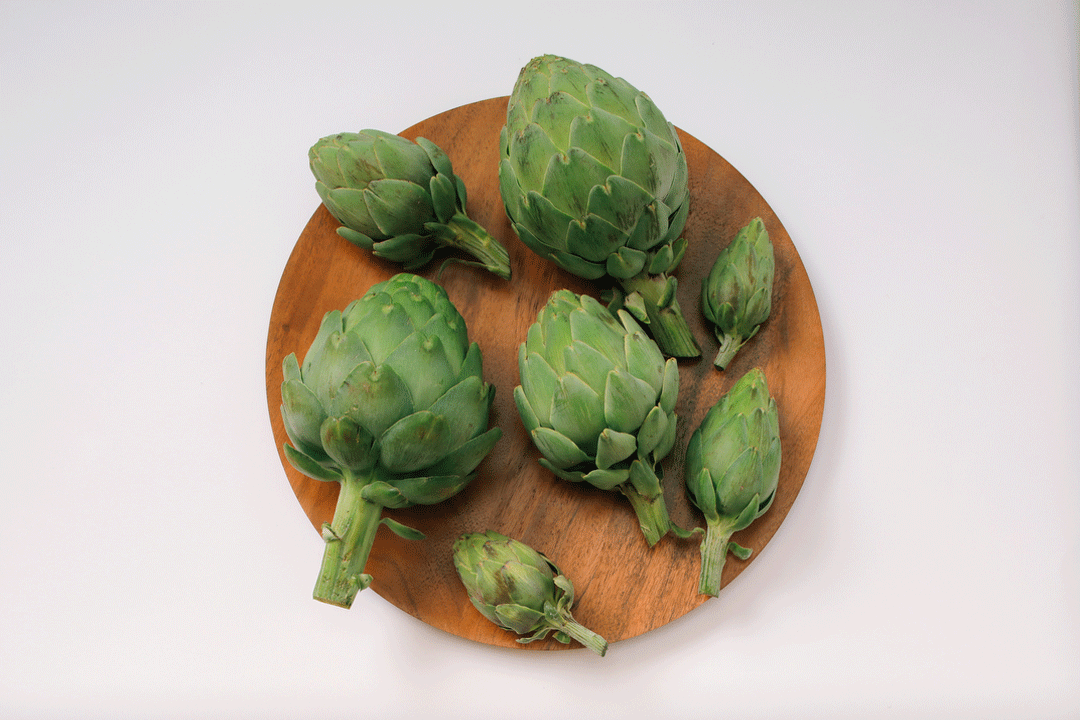A Rising Star: New Artichoke Variety Taking Hold
- Share via
This is the peak season for artichokes, the exotic thistle that put on the map Castroville, the self-proclaimed Artichoke Capital of the World. From the misty valleys encircling this Northern California town originates 90% of the country’s commercial crop.
Although San Diego and Imperial counties’ production pose no threat to the tons of artichokes produced along California’s Central Coast, local consumers in search of farm-fresh artichokes may be happy to learn that modern-day technology has made available new varieties suited to drier areas of the state, including North County.
The heat-tolerant Imperial Star artichoke as the enticing new variety is called, took seven years to develop, according to Wayne Schroeder, a UC Cooperative Extension farm adviser who specializes in vegetable and strawberry production for San Diego County. Schroeder worked on the project in tandem with Keith Mayberry, his UC Cooperative counterpart in the Imperial Valley, where 400 acres of Imperial Star were grown this year.
This artichoke grows from seed rather than from a cutting from the mother plant, and was bred specifically to complement Castroville’s early spring production. Mayberry credits Joe Principe, a technician with the USDA in Brawley, with the first attempts at developing the Imperial Star.
It was Principe who first crossed Green Globes and Italian Thorny artichokes looking specifically for earliness and flavor. “One of the offspring turned out to have characteristics of the Imperial Star,” explained Mayberry. “The artichoke is well adapted to coastal or desert regions. It likes the heat a little more (than the regular artichoke) but it is well-suited to San Diego County back yards.”
Each bush yields about a dozen large artichokes, and sometimes more than 20 baby artichokes. Mayberry describes the plant as “a little like a sleeping giant,” developing from the size of a dinner plate the first month or two, to a 5-foot-tall bush expanding 3 to 4 inches a day during the last 6 weeks before harvest. The experiment has proved a rousing success, both among growers experimenting with the vegetable and among consumers, who may one day be able to enjoy fresh artichokes practically year-round.
Allen and Lucky Yasukochi of Valley Heights Ranch Ltd. decided this year to experiment with the latest artichoke variety, and the tubful of freshly picked green-gray globes on display at their Oceanside stand is testament to their success.
Allen Yasukochi put 200 artichoke plants in the ground in his North County fields over a year ago. “We thought we would only have enough for our family’s use,” says Lucky, “but we keep getting more each day.”
The new artichoke is practically fuzzless, and sports spineless green leaves, called bract, delicately edged in purple. It boasts a slightly sweeter taste than Castroville’s large Green Globe artichoke, the variety most commonly found in supermarkets. Indeed, the tender inner leaves of the baby, or cocktail-size Imperial Star artichokes, once cooked and marinated, are completely edible, unlike their larger cousins.
Gary Fusi of Holtville is among a handful of Imperial Valley growers also experimenting with the Imperial Star. Fusi added artichokes to his alfalfa crop at his son’s suggestion. “I like artichokes, and it’s my son’s favorite vegetable,” he said.
This year, the Fusis have been able to grow enough for their own use as well as produce a surplus to sell at the Vista Farmer’s Market. The experience has proven so positive that Fusi may increase his acreage next year.
“It’s cheaper to grow artichokes than to buy them in the store,” he says. “And it’s not a vegetable that’s readily available in our area.” Like the Yasukochis, this is a first for the Fusis. Both farmers are still evaluating the cost effectiveness of the vegetable as a commercial crop. Good rains helped this year’s crop, says Fusi, adding that the temperature is a determining factor in crop yield. “It’s just a gamble,” he adds. For this year, at least, the gamble seems to have paid off.
The use of artichokes, a staple of European kitchens, remains a puzzle for some consumers. Look for healthy, compact, plump globes, with tightly-packed leaves. Refrigerate to prevent artichoke from drying out. Boil artichokes in lemon water until an outer leaf, or bract, can easily be pulled off. Dip the base of the leaf in melted lemon-butter, or in your favorite dip or salad dressing. Artichokes, cooked or raw, make spectacular natural containers: Spread the leaves until the central cone is exposed, and gently pull out the cone and the fuzz, if there is any. Fill the center with dip.
To microwave, wash the artichokes, and cut off the stem even with the base. Set a medium-sized artichoke upside down in a microwaveable dish, with a quarter of a cup water and a few drops of lemon juice. Cover with plastic wrap, and microwave on high for 6 to 7 minutes. Let stand 5 minutes before removing the wrap. A 12-ounce artichoke contains 25 calories, no fat, 4 grams of dietary fiber, 185 milligrams of potassium and no sodium, according to the California Artichoke Advisory Board.
Valley Heights Ranch, Ltd. 757-5914. Stand located just east of entrance to Oceanside drive-in theater and west of Fireside Street. Open daily 9:30 a.m. to 4:30 p.m. Artichokes, 50 cents apiece.
Ambra and Gary Fusi, Fusi Roadsiding, 1736 East Thiesen Road, Holtville. 356-4133. Vista Farmer’s Market: 2 for $1.
California Artichoke Advisory Board, P.O. Box 747, Castroville CA 95012. (408) 633-4411.





